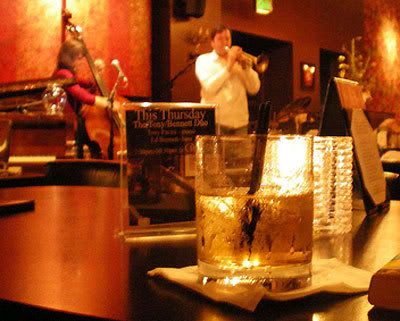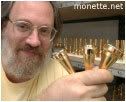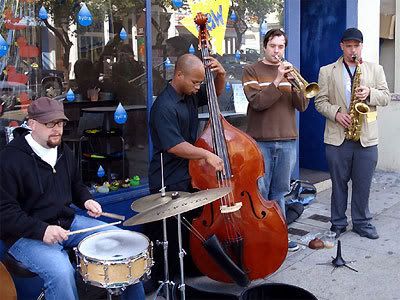Hi listeners-- I know it's been a while with no updates. Unfortunately I haven't been performing nearly as often as I'd like lately (an Obama fundraiser here, a street fair there), and with the recent closing of two more San Francisco jazz venues (Jazz at Pearl's and the Octavia Lounge), prospects don't seem encouraging. Pearl's was an especially tough blow, as it was home to the Contemporary Jazz Orchestra, which I really enjoyed playing with once or twice a month. But no excuses, we musicians just have to get out there and find new places to play.In this month's JazzTimes and in a post on his blog, the great jazz writer Marc Myers takes a critical look at the cult of adoration surrounding Miles Davis' Kind of Blue (1959), which has been widely hailed as the greatest (or at least most essential) jazz album of all time. The post is definitely worth a read, as it places the album in the context of its time and looks at factors (on both the musical and the marketing sides) which contributed to its lofty stature.
After mulling the post over for a few days and seeing Marc accused of being a "reactionary nitpicker," I left the following comment which sums up my feelings about Kind of Blue, and why, for once, I agree with the "conventional wisdom":
I know Marc ISN'T a reactionary nit-picker, so I took this post as a legitimate question, and one that deserves to be asked periodically of any canonical artwork.Aside from the question of whether KoB can be separated from its reputation, as I thought about this post I realized the more difficult task for me was separating it from my memories of the record. Although I'd grown up hearing my dad's copies of the Miles/Gil Evans compilations, KoB was the first jazz CD I bought myself, mainly because of its rep (and despite the cheesy cover the first Columbia CD issue featured). My first listen to it was a sort of rubicon, and maybe because of its reputation, I listened to it with a focus I'd never given any other album. It was moody without being somber; bluesy without being corny; intelligent without being effete; virtuosic without being cold.And even though over the years I've come to see it in the continuum of Miles' output (and jazz history in general), it still remains above and beyond for me because of that near-religious response I initially had to it, and which has stuck with me.The other records mentioned are great, too, but I hear them as great jazz albums, whereas KoB still feels like the Gutenberg bible (even if I hear it in Starbucks). How much of that is due to the hype-based expectations of a teenager, it's hard to say--but I'd still rather take it to a desert island than any other jazz record.
I also read an interesting post by the excellent New York jazz writer Howard Mandel talking about his visit to Berklee College of Music and the incredible number of young musicians still dedicating themselves to jazz even as the market dwindles. It reminded me of my student days, and I left the following comment:
I've often wondered whether it would've been helpful for someone to clue me in to the incredible imbalance of supply and demand in the jazz world when I was going into a mountain of debt to finance my jazz education at the New School... (I think I remember my roommate at the time telling me that the average starting salary of a Parsons design grad was over $50,000, and thinking that the average starting salary of a New School Jazz grad would be tips and a beer.) However, I probably wouldn't have listened if they had, since I was young and invincible and little things (like the fact that there seem to be more people making jazz than listening to it) couldn't faze me.
Howard nicely responded with this note: "... I don't mean to dissuade anyone from studying jazz; as you write the power of jazz to attract the young and invincible is stronger than financial considerations for them. Those of us involved in the music though ought to look at our society clearly, and consider how to work with the gap between what we're called to do and how we can live. This is what jazz musicians have done since the get-go. I think such reality-checks strengthen the musician and the music. Who said it was gonna be easy?" Damn straight.




 First of all, thanks to everyone who came out to last week's shows. We had a great time performing at Anna's in Berkeley—had a good crowd, sold some CDs, ate some carnitas tacos—which was only slightly marred by accidentally leaving our car in the garage past the midnight deadline. (No harm done, though—Linda heroically got up early and rode the BART over to retrieve it the next morning.)
First of all, thanks to everyone who came out to last week's shows. We had a great time performing at Anna's in Berkeley—had a good crowd, sold some CDs, ate some carnitas tacos—which was only slightly marred by accidentally leaving our car in the garage past the midnight deadline. (No harm done, though—Linda heroically got up early and rode the BART over to retrieve it the next morning.)